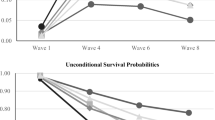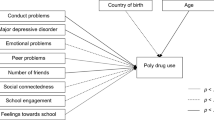Abstract
Data on marijuana and heroin use were obtained from 969 adolescents in Hong Kong, part of them being offenders. Very high drug use prevalence rates were found, which is due to the unique population studied. All but two of the heroin users were incarcerated youth. Drug use frequencies were highly associated with psychosocial variables such as sensation seeking, peer drug use, family drug use, susceptibility to peer pressure, perceived control to gain access to drugs, intention to try other substances, and perceived adverse consequences of drug use. Interactions were found indicating, for example, that regularly marijuana using girls and occasionally heroin using girls were characterized by higher levels of sensation seeking and susceptibility to peer pressure than their male counterparts. Polysubstance use was generally related to high levels of psychosocial vulnerability factors. The exclusive use of marijuana was associated with high susceptibility to peer pressure and with perceived control to gain access to drugs. The findings reflect a complex interplay of psychosocial variables with substance use in adolescents that, however, cannot be generalized beyond this particular sample in Hong Kong.
Similar content being viewed by others
References
Alberts, J. K., Hecht, M. L., Miller-Rassulo, M., and Krizek, R. L. (1992). The communicative process of drug resistance among high school students.Adolescence 27: 203–226.
Andrucci, G. L., Archer, R. P., Pancoast, D. L., and Gordon, R. A. (1989). The relationship of MMPI and Sensation Seeking scales to adolescent drug use.J. Personal. Assess. 53: 253–266.
Anglin, M. D., Hser, Y., and Chou, C. (1993). Reliability and validity of retrospective behavioral self-report by narcotics addicts.Eval. Rev. 17: 91–108.
Baer, J. S., Marlatt, G. A., and McMahon, R. (Eds.). (1993).Addictive Behaviors Across the Life Span. Sage, Newbury Park, CA.
Bandura, A. (1992). Self-efficacy mechanism in psychobiologic functioning. In Schwarzer, R. (ed.),Self-Efficacy: Thought Control of Action. Hemisphere, Washington.
Barnea, Z., Teichman, M., and Rahav, G. (1992). Personality, cognitive, and interpersonal factors in adolescent substance use: A longitudinal test of an integrative model.J. Youth Adolesc. 21: 187–201.
Belkin, B. M., and Miller, N. S. (1992). Agreement among laboratory tests, self-reports, and collateral reports of alcohol and drug use.Ann. Clin. Psychiat. 4, 33–42.
Bentler, P. M. (1992). Etiologies and consequences of adolescent drug use: Implications for prevention.J. Addic. Dis. 11: 47–61.
Biddle, B., Bank, B., and Marlin, M. (1980). Social determinants of adolescent drinking.J. Studies Alcohol 41: 215–241.
Botvin, G. J., Baker, E., Goldberg, C. J., and Dusenbury, L. (1992). Correlates and predictors of smoking among Black adolescents.Addic. Behav. 17: 97–103.
Dielman, T. E., Butchart, A. T., Shope, J. T., and Miller, M. (1990). Environmental correlates of adolescent substance use and misuse: Implications for prevention programs.Int. J. Addic. 25: 855–880.
Dielman, T. E., Campanelli, P. C., Shope, J. T., and Butchart, A. T. (1987). Susceptibility to peer pressure, self-esteem, and health locus of control as correlates of adolescent substance use.Health Educat. Quart. 14: 207–221.
Donovan, J. E., and Jessor, R. (1978). Adolescent problem drinking: Psychosocial correlates in a national sample study.J. Studies Alcohol 39: 1506–1524.
Donovan, J. E., and Jessor, R. (1985). Structure of problem behavior in adolescence and young adulthood.J. Counsel. Consult. Psychol. 53: 905–912.
Ellickson, P. L., and Hays, R. D. (1992). On becoming involved with drugs: Modeling adolescent drug use over time.Health Psychol. 11: 377–385.
Farrell, A. D., Danish, S. J., and Howard, C. W. (1992). Risk factors for drug use in urban adolescents: Identification and cross-validation.Am. J. Commun. Psychol. 20: 263–286.
Goddard, E. (1992). Why children start smoking.Brit. J. Addict. 87: 17–18.
Hammersley, R. H., Lavelle, T. L., and Forsyth, A. J. (1992a). Predicting initiation to and cessation of buprenorphine and temazepam use amongst adolescents.Brit. J. Addict. 87: 1303–1311.
Hammersley, R., Lavelle, T. L., and Forsyth, A. J. (1992b). Adolescent drug use, health and personality.Drug Alcohol Depend. 31: 91–99.
Hansell, S., and Mechanic, D. (1990). Parent and peer effects on adolescent health behavior. In K. Hurrelmann and F. Lösel (Eds.),Health Hazards in Adolescence, de Gruyter, Berlin.
Huba, G. J., Newcomb, M. D., and Bentler, P. M. (1981). Comparison of canonical correlation and interbattery factor analysis on sensation seeking and drug use domains.Appl Psychol. Measure. 5: 291–306
Iannotti, R. J., and Bush, P. J. (1992). Perceived vs. actual friends' use of alcohol, cigarettes, marijuana, and cocaine: Which has the most influence?J. Youth Adolesc. 21: 375–389
Jaffe, L. T., and Archer, R. P. (1987). The prediction of drug use among college students from MMPI, MCMI, and Sensation Seeking Scales.J. Personal. Assess. 51: 243–253.
Jessor, R. (1987). Problem-behavior theory, psychosocial development, and adolescent problem drinking.Brit. J. Addict. 82: 331–342.
Jessor, R. (1993). Successful adolescent development among youth in high-risk settings.Am. Psychol. 48: 117–126.
Kandel, D. B. (1980). Drug and drinking behavior among youth.Ann. Rev. Sociol. 6: 235–285.
Marlatt, G. A., Baer, J. S., and Quigley, L. A. (1994). Self-efficacy and addictive behavior. In Bandura, A. (ed.),Self-Efficacy in Changing Societies. Johann Jacobs Foundation, Marbach, Germany.
Maton, K. I., and Zimmerman, M. A. (1992). Psychosocial predictors of substance use among urban Black male adolescents.Drugs Society 6: 79–113.
McNeill, A. (1992). Why children start smoking: The need for a comprehensive tobacco control policy.Brit. J. Addict. 87: 24–25.
Newcomb, M. D., and Bentler, P. M. (1988a).Consequence of Adolescent Drug Use: Impact on the Lives of Young Adults. Sage, Beverly Hills, CA.
Newcomb, M. D., and Bentler, P. M. (1988b). Impact of adolescent drug use and social support on problems of young adults: A longitudinal study.J. Abnorm. Psychol. 97: 64–75.
Newcomb, M. D., and Felix-Ortiz, M. (1992). Multiple protective and risk factors for drug use and abuse: Cross-sectional and prospective findings.J. Personal. Social Psychol. 63: 280–296
Newcomb, M. D., Maddahian, E., Skager, R., and Bentler, P. M. (1987). Substance abuse and psychosocial risk factors among teenagers: Associations with sex, age, ethnicity, and type of school.Am. J. Drug Alcohol Abuse 13: 413–433.
Newcomb, M. D., and McGee, L. (1991). Influence of sensation seeking on general deviance and specific problem behaviors from adolescence to young adulthood.J. Personal. Social Psychol. 61: 614–628.
Rose, R. L., Bearden, W. O., and Teel, J. E. (1992). An attributional analysis of resistance to group pressure regarding illicit drug and alcohol consumption.J. Consum. Res. 19: 1–13.
Schwarzer, R. (Ed.). (1992).Self-Efficacy: Thought Control of Action. Hemisphere, Washington, D.C.
Schwarzer, R. (1994). Optimism, vulnerability, and self-beliefs as health-related cognitions: A systematic overview.Psychol. Health 9: 161–180.
Segal, B. (1990).Drug Taking Behavior Among School-Aged Youth: The Alaska Experience and Comparisons with Lower-48 States. Haworth Press, New York.
Skog, O. J. (1992). The validity of self-reported drug use.Br. J. Addict. 87: 539–548.
Smith, C., and Nutbeam, D. (1992). Adolescent drug use in Wales.Br. J. Addict. 87: 227–233.
Stacy, A. W., Bentler, P. M., and Flay, B. R. (1994). Attitudes and health behavior in diverse populations: Drunk driving, alcohol use, binge eating, marijuana use, and cigarette use.Health Psychol 13: 73–85.
Stacy, A. W., Newcomb, M. D., and Bentler, P. M. (1992). Interactive and higher-order effects of social influences on drug use.J. Health Social Behav. 33: 226–241.
Stacy, A. W., Newcomb, M. D., and Bentler, P. M. (1993). Cognitive motivation and sensation seeking as long-term predictors of drinking problems.J. Social Clin. Psychol. 11: 1–21.
Stanton, W. R., and Silva, P. A. (1992). A longitudinal study of the influence of parents and friends on children's initiation of smoking.J. App. Develop. Psychol. 13: 423–434.
Stein, J. A., Newcomb, M. D., and Bentler, P. M. (1987). An 8-year study of multiple influences on drug use and drug use consequences.J. Personal. Social Psychol. 53: 1094–1105.
Vega, W. A., Gil, A. G., and Zimmerman, R. S. (1993). Patterns of drug use among Cuban-American, African-American, and White non-Hispanic boys.Am. J. Public Health 83: 257–259.
Wagenaar, A. C., Komro, K. A., McGovern, P., Williams, C. L.,et-al. (1993). Effects of a saliva test pipeline procedure on adolescent self-reported alcohol use.Addiction 88: 199–208.
Watson, D., and Clark, L. A. (1993). Behavioral disinhibition versus constraint: A dispositional perspective. In Wegner, D. M., and Pennebaker, J. W. (eds.),Handbook of Mental Control. Prentice Hall, Englewood Cliffs, N.J.
Webster, R. A., Hunter, M., and Keats, J. A. (1994). Peer and parental influences on adolescents' substance use: A path analysis.Int. J. Addict. 29: 647–657.
Yu, J., and Williford, W. R. (1992). The age of alcohol onset and alcohol, cigarette, and marijuana use patterns: An analysis of drug use progression of young adults in New York State.Int. J. Addict. 27: 1313–1323.
Zane, N., and Sasao, T. (1992). Research on drug abuse among Asian Pacific Americans.Drugs Society 6: 181–209.
Zimmerman, M. A., and Maton, K. I. (1992). Life-style and substance use among male African-American urban adolescents: A cluster analytic approach.Am. J. Commun. Psychol. 20: 121–138.
Zuckerman, M. (1971). Dimensions of sensation seeking.J. Consult. Clin. Psychol. 36: 45–52.
Zuckerman, M. (1979).Sensation Seeking: Beyond the Optimal Level of Arousal. Erlbaum, Hillsdale, NJ.
Zuckerman, M. (1991).Psychobiology of Personality. Cambridge University Press, New York.
Author information
Authors and Affiliations
Additional information
Received Ph.D. in Clinical Psychology from the University of North Texas. Research interests include drug-taking behaviors, health psychology and women studies. To whom correspondence should be addressed.
Received M. Phil in Clinical Psychology from the Chinese University of Hong Kong. Research interests include drug-taking behaviors and adolescent problems.
Research interests include stress and anxiety.
Rights and permissions
About this article
Cite this article
Tang, C.S.K., Wong, C.S.Y. & Schwarzer, R. Psychosocial differences between occasional and regular adolescent users of Marijuana and Heroin. J Youth Adolescence 25, 219–239 (1996). https://doi.org/10.1007/BF01537345
Received:
Accepted:
Issue Date:
DOI: https://doi.org/10.1007/BF01537345




